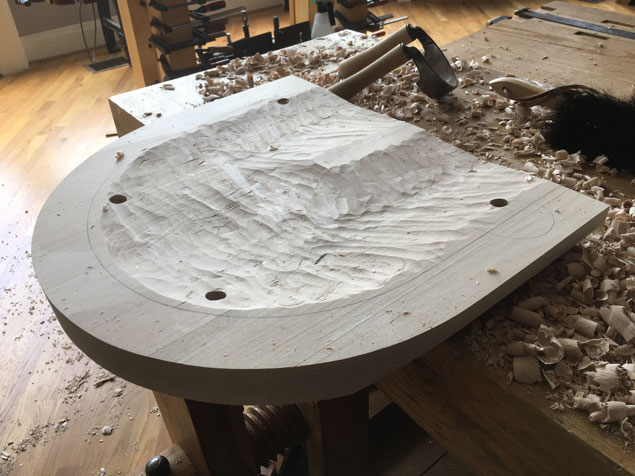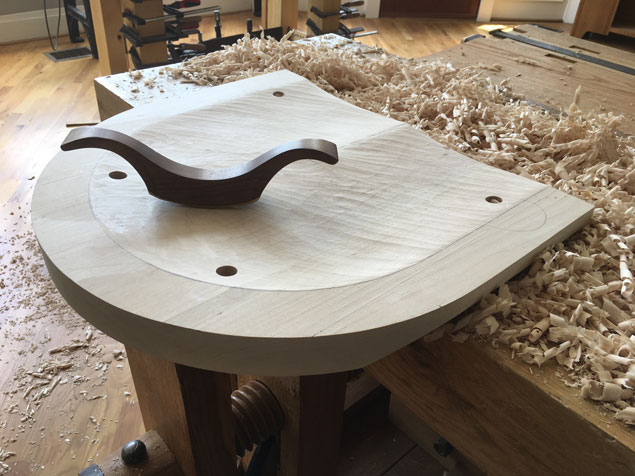We may receive a commission when you use our affiliate links. However, this does not impact our recommendations.
Though I’ve built a lot of chairs, I don’t own an adze, which is used to roughly shape a plank seat so it has a buttocks-shaped depression. I also don’t own any of the typical power-tool solutions, such as an angle grinder outfitted with a special cutter for seats.
Instead, I have a scorp, which is like a drawknife that was bent around a telephone pole. It’s much slower in use compared to an adze, but it will do the job and also give your wrists and forearms a workout.
Last week I started to saddle a chair seat in a piece of hard maple, and my wrists reminded me of how sore they were going to be after 45 minutes of scorp work. So I picked up a cordless drill and a 1-1/8” Forstner bit instead.
The ersatz plan was to bore out most of the seat with the Forstner. And use the depth of each hole to contour the seat. The deeper holes would be in the middle with shallower holes near the edge.
I did this entirely freehand. When I measured my Forstner bit from the tip of its centerpoint to the top of its rim, it was 1/2” – that’s a good depth for the bottom of the saddle. So I drilled out the lowest spot of the seat by sinking the Forstner to the top of its rim.
Then I surrounded those holes with holes where I sank the Forstner to one-half of that depth. Finally I surrounded those holes with more holes that were one-fourth of the full depth.
The entire process took about six or seven minutes. In the end I had a rough, contoured map of my seat. And that’s when I grabbed my scorp. I quickly removed the waste left between the holes with little effort. Then I moved onto the travisher and the scraper.
In all, using the drill reduced my time and effort by about half. It didn’t diminish the fun part – shaping the seat with the travisher. And I didn’t have to buy a new tool.
Of course, I didn’t invent this technique. Some violin makers use it to roughly shape the backs of violins. But it’s worth trying if you own a drill and a Forstner.
— Christopher Schwarz
Here are some supplies and tools we find essential in our everyday work around the shop. We may receive a commission from sales referred by our links; however, we have carefully selected these products for their usefulness and quality.












a
Seems like a lot of hard work to me and unnecessary, when I made my Double bow Wheel Backed Windsor I drilled four holes to mark my depths and then ripped into the seat with an Arbotech wheel in the angry grinder, all up it took me about 20 munutes beforre I startes in with the Travisher.
I couldn’t use an adaze or a scorp because of torn and detached Rotor-cuff tendons in my shoulders.
This is a popular way for people to learn to shape an archtop guitar’s top, as well.
An adze isn’t super hard to make if you go with a Pacific Northwest style, you can buy the O1 steel on Amazon. Heat it up, pound it to the radius you want, then heat until it isn’t magnetic and quench and temper in your kitchen oven. Then you cut out a handle and lash it to it with twine.
https://www.woodworkingchat.com/forum/drugs/carvings/30326-carving-adze
Here shows the forging… even with a less-than-ideal setup it went well enough.
https://www.woodworkingchat.com/forum/main-forum/project-showcase/28266-pay-it-forward-build
I like seeing the shavings on the workbench change after each operation.
I’m more of an “adze man” (someone had to).
Excellent resourcefulness! I like this approach.
Nice tip for the rest of us adze-less! Thanks!
Neat! Any particular reason the grain is oriented parallel to the buttcrack instead of perpendicular like your other staked chairs?